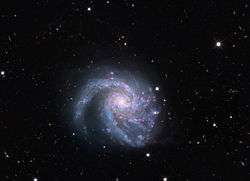Messier 99
| Messier 99 | |
|---|---|
|
Spiral Galaxy M99 taken at the Mount Lemmon SkyCenter using the 0.8m Schulman Telescope. | |
| Observation data (J2000 epoch) | |
| Constellation | Coma Berenices[1] |
| Right ascension | 12h 18m 49.6s[2] |
| Declination | +14° 24′ 59″[2] |
| Redshift | 0.008029[2] |
| Helio radial velocity | 2407 ± 3 km/s[2] |
| Distance |
55.7 Mly (15.4 ± 1.7 Mpc)[3] |
| Apparent magnitude (V) | 10.4[2] |
| Characteristics | |
| Type | SA(s)c[2] |
| Apparent size (V) | 5′.4 × 4′.7 |
| Other designations | |
| NGC 4254,[2] UGC 7345,[2] PGC 39578,[2] Coma Pinwheel Galaxy,[4] Virgo Cluster Pinwheel[4] | |
Messier 99 (also known as M99 or NGC 4254) is an unbarred spiral galaxy approximately 50 million light-years away[3] in the constellation Coma Berenices.
History
Messier 99 was discovered by Pierre Méchain on March 17, 1781. The discovery was then reported to Charles Messier, who included the object in the Messier Catalogue, which was the first astronomical catalogue of star clusters, nebulae, and galaxies.[5]
Messier 99 was one of the first galaxies in which a spiral pattern was seen. The spiral pattern was first identified by Lord Rosse in the spring of 1846.[5]
Characteristics
The galaxy has a normal looking arm and an extended arm that is less tightly wound. A bridge of neutral hydrogen gas links NGC 4254 with VIRGOHI21, a HI region and a possible dark galaxy. The gravity from the latter may have distorted M99 and drawn out the gas bridge, as the two galaxy-sized objects may have had a close encounter, before they went their separate ways (however the existence of VIRGOHI21 is unclear and another candidate is the lenticular galaxy NGC 4262 with this event having taken place 280 million years ago).[6] It is expected that the drawn out arm will relax to match the normal arm once the encounter is over. Four supernovae have been observed in this galaxy.
While not classified as a starburst galaxy, M99 has a star formation activity three times larger than other galaxies of similar Hubble type that may have been triggered by that encounter.[7]
Some authors also suggest that M99 is entering the Virgo Cluster for the first time and, after the aforementioned interaction, its suffering ram-pressure stripping as it moves through the intracluster medium.[6]
Gallery
 Image of Messier 99 taken by the NASA/ESA Hubble Space Telescope.[8]
Image of Messier 99 taken by the NASA/ESA Hubble Space Telescope.[8]
See also
- Messier 83 - a similar face-on spiral galaxy
- Pinwheel Galaxy - a similar face-on spiral galaxy
References
- ↑ R. W. Sinnott, ed. (1988). The Complete New General Catalogue and Index Catalogue of Nebulae and Star Clusters by J. L. E. Dreyer. Sky Publishing Corporation/Cambridge University Press. ISBN 0-933346-51-4.
- 1 2 3 4 5 6 7 8 9 "NASA/IPAC Extragalactic Database". Results for NGC 4254. Retrieved 2006-11-25.
- 1 2 "Distance Results for MESSIER 099". NASA/IPAC Extragalactic Database. Retrieved 2010-04-30.
- 1 2 "SIMBAD Astronomical Database". Results for NGC 4254. Retrieved 2006-11-25.
- 1 2 K. G. Jones (1991). Messier's Nebulae and Star Clusters (2nd ed.). Cambridge University Press. ISBN 0-521-37079-5.
- 1 2 Vollmer, B.; Huchtmeier, W.; van Driel, W. (September 2005). "NGC 4254: a spiral galaxy entering the Virgo cluster". Astronomy and Astrophysics. 439 (3): 921–933. arXiv:astro-ph/0505021
 . Bibcode:2005A&A...439..921V. doi:10.1051/0004-6361:20041350.
. Bibcode:2005A&A...439..921V. doi:10.1051/0004-6361:20041350. - ↑ Chyży, K. T.; Ehle, M.; Beck, R. (September 2007). "Magnetic fields and gas in the cluster-influenced spiral galaxy NGC 4254. I. Radio and X-rays observations". Astronomy and Astrophysics. 474 (2): 415–429. arXiv:0708.1533
 . Bibcode:2007A&A...474..415C. doi:10.1051/0004-6361:20077497.
. Bibcode:2007A&A...474..415C. doi:10.1051/0004-6361:20077497. - ↑ "A Bright Spark in a Nearby Spiral Galaxy". ESA/Hubble Picture of the Week. Retrieved 4 June 2012.
External links
| Wikimedia Commons has media related to Messier 99. |
- SEDS: Spiral Galaxy M99
- UniverseToday: Dark Matter Galaxy?
- PPARC: New evidence for a Dark Matter Galaxy
- PTF10fqs: A Luminous Red Nova in the Spiral Galaxy Messier 99
- Messier 99 on WikiSky: DSS2, SDSS, GALEX, IRAS, Hydrogen α, X-Ray, Astrophoto, Sky Map, Articles and images
Coordinates: ![]() 12h 18m 49.6s, +14° 24′ 59″
12h 18m 49.6s, +14° 24′ 59″

